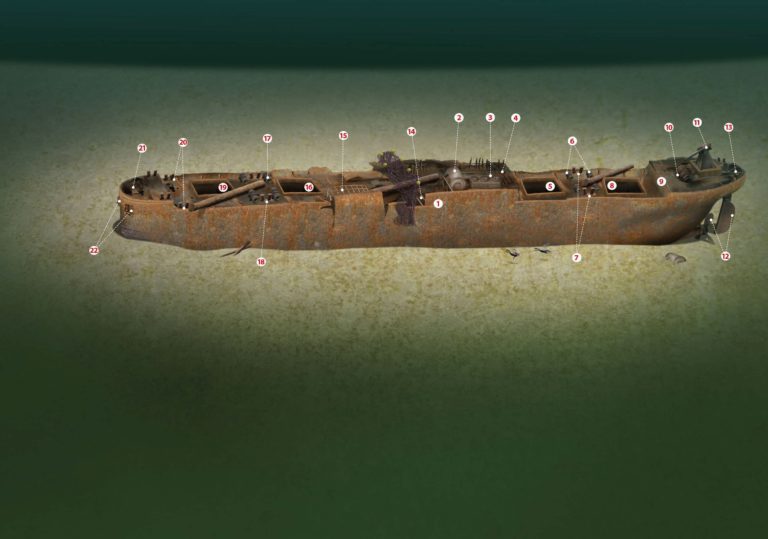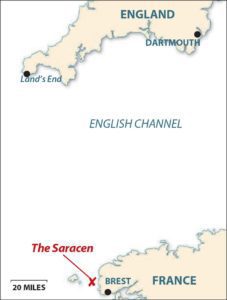The sinking of this French steamer off Brittany in 1917, reportedly by a long-vanished U-boat, was part of a great WW1 mystery. JOHN LIDDIARD conducts the tour, illustration by MAX ELLIS
I JOINED MV MAUREEN for a tour of Brittany wrecks a few years ago, and at the end of the trip I asked everyone which wrecks they liked most. Two came out top: the French ironclad cruiser Kleber and the 3272-ton steamship Saracen, both World War One victims.
We have already Wreck Toured the Kleber (44, October 2002), so having stayed away from Brittany for a while, this month it’s the turn of the Saracen.
The wreck is located in the Chenal du Four, notorious for strong and unstable currents. Under these conditions, even for a wreck as big as the Saracen, the best option when dropping a shot is to aim for the middle, so that is where our tour begins (1), with the shot hooked onto the port side of the wreck.
The depth to the deck is about 48m on a high-water slack, or a few metres shallower on a low-water slack.
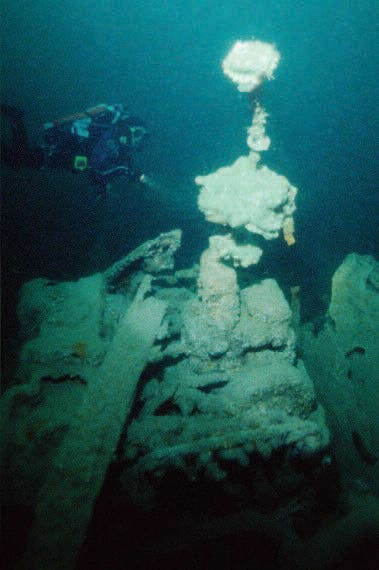
As it is a while since I dived the Saracen, I checked the condition of the wreck with Mike Rowley. He informs me that the significant change is a heavy trawl net across the ship just forward of the boilers that trails across this area, so caution is required to make sure that no accidental entanglement occurs.
Unusually, the donkey boiler (2) is level with the top of the wreck. I can only surmise that it tore loose and floated upwards as the wreck sank, becoming jammed in place.
Behind the donkey boiler, the top of the three-cylinder triple-expansion engine is exposed, just below the level of the intact sides of the hull (3).
Aft of the engine, a winch that would originally have been mounted at the back of the boat deck has fallen part of the way to the main deck (4).
The main deck itself has also begun to collapse, sagging inward about the hold coaming for the first hold aft (5). The more robust deck between the holds has survived this collapse, with four winches (6) set about the foot of the mast. Pairs of large bollards stand on either side (7).
The mast itself has fallen aft and to starboard, across the corner of the aftmost hold (8). Like the previous hold, the deck here has collapsed so that it sags toward the hold coaming.
At the stern, the deck rises again (9).
As at the back of the boat deck, another cargo winch has fallen partway through the deck (10).
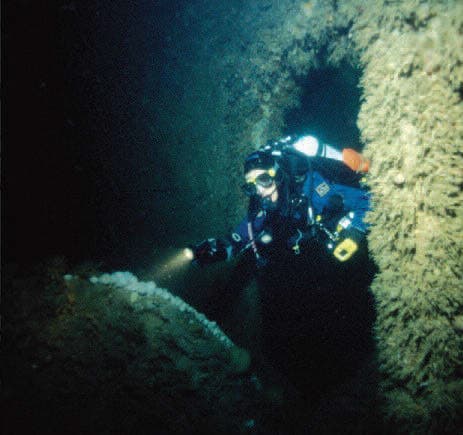
The main feature at the stern is the gun, still on its mounting but sagging over the starboard side (11).
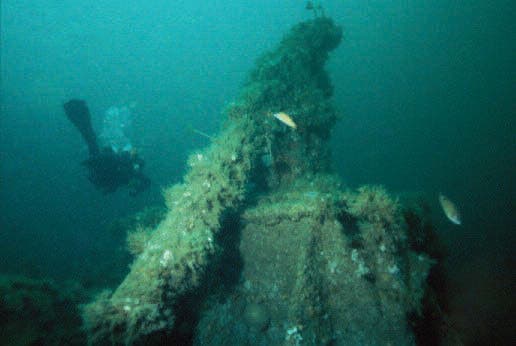
For those wanting to stay shallower than the BSAC air diving limit, on a high-water slack the propeller and rudder (12) are just beyond reach at 54m.
Back on deck at the top of the rudder shaft, a big steering quadrant (13) fills most of the deck between two pairs of bollards.

With a big and deep wreck, any tour to see all of it in one go has to be fast, so it’s a quick swim back past the shot, keeping an eye out for the fishing net across the centre of the wreck. It’s also a good idea to confirm the location of the shot at this stage of the dive, so that it’s easier to navigate back to it later, when time is more pressing.
Forward of the donkey boiler, the debris from the superstructure largely obscures the main boiler (14), but glimpses can be seen through some gaps in the wreckage.
The boat deck and debris continues forwards, with the sides of the hull beginning to cave in so that a section of railing towards the front of the boat deck is now tilted into the wreck (15).
Like the aft holds, the decks about the forward holds (16) are sagging inward about the hold coamings.
Winch gear between the forward holds is identical to that between the aft holds, with four winches (17) set about the mast foot and pairs of bollards to either side of the deck (18).
This time the mast has fallen forward and to port across the forward hold (19).
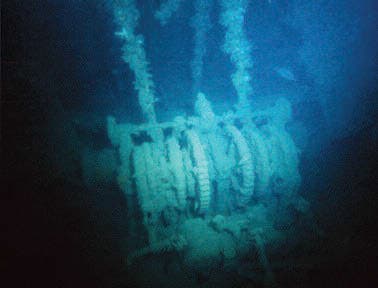
The forward end of the main deck is marked by pairs of mooring bollards (20) immediately before the hull rises to the forecastle. On the forecastle, the deck beneath the anchor winch has collapsed, taking the winch and some of the bollards with it (21).
The anchor chains still stretch from the winch and through the hawse pipes, holding anchors in place on both sides of the bow (22).
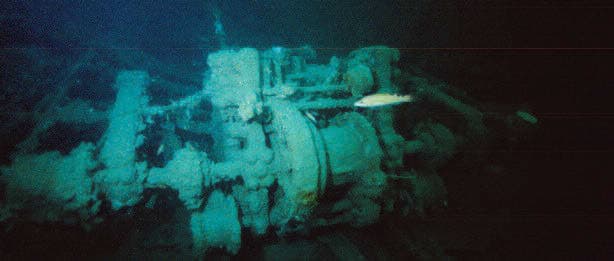
Options for ending the dive depend on the skipper. If the instructions are to use a delayed SMB, here is a good place to launch it and drift off well clear of the nets near the boilers.
On the other hand, with a big current building and long decompression stops, collecting all the divers together on a decompression station may require a return to the shot.
Thanks to Mike, Penny and Giles Rowley.
SUNK BY A GHOST
SARACEN, ore-carrier. BUILT 1911, SUNK 1917
HEAVILY LADEN WITH IRON ORE, taken on board at Bilbao, the 3272-ton French steamship Saracen left Spain with orders to carry it to Glasgow.
Instead, Saracen and the ore ended up 50m down on the seabed near Ushant on Boxing Day, 1917, becoming part of one of the great sea mysteries of World War One, writes Kendall McDonald.
Saracen was built in Sunderland by J Priestman & Co for the Ottoman Line of Newport, and launched in the same year, 1911. She was 340ft long, with a 48ft beam and 23ft draught.
Her triple-expansion engines, made in Britain by George Clark Ltd, provided a decent top speed for a hard-worked steamer of 10 knots. She had visited most European ports by the time war closed many of them to her.
During the middle war years Saracen was fitted with a big but old stern gun, though there is no record of her firing it in anger.
In 1917 she was sold to the French Letricheux Line, and continued working for the Allies. On 23 December she sailed for Glasgow, and the next day crossed the Bay of Biscay and headed in for Brest.
Late on Christmas Day she swung into the northern fork of the swept channel leading inside the shelter of Ushant, along the tide-ripped Chenal du Four. The captain thought he was safe from U-boats there, but in the pre-dawn light a colossal explosion crumpled the port bow and started the ship on a slow slide under.
Most of the crew took to the boats and saw the ship spin away below the surface in a giant Catherine wheel of white foam.
The captain and crew were sure that they had been torpedoed, but the French wreck register noted: ’Sunk by a mine laid by German submarine UC36’.
This is where the mystery becomes almost unbelievable. UC36 is recorded as sunk on or about 19 May, 1917.
There is no doubt that its Kapitanleutnant Georg Buch was ordered to lay mines off the Nab Light Vessel and the Needles, and that he left Zeebrugge on 16 May.
The mines he laid off the Nab were swept but none was ever found off the Needles. UC36 and its 27 men were never seen again. British records suggest that she might have been sunk by the explosion of her own mines.
If the French records are right in stating that the mine that sank the Saracen was from UC36, its mines, with or without their U-boat, must have been drifting down the Channel and round to Ushant for seven months first. Perhaps someone on a wreck tour will find the answer.
TOUR GUIDE
GETTING THERE: From the end of the M5 continue south on the A38. Turn left on the A384 for Totnes, then the A3122 for Dartmouth. mv Maureen picks up from the floating jetty just into the one-way system.
Having unloaded, the nearest long-stay car park is the park-and-ride at the top of the hill, though you may be lucky enough to find a closer space on a side street.
HOW TO FIND IT: The GPS position is 48 25.37N, 004 52.22W, the wreck lying across the tide with its bow to the east.
TIDES: With a typically 6m tidal range slack is essential, and coincides with high and low water at Brest.
DIVING, ACCOMMODATION & AIR: mv Maureen, skipper Mike Rowley, 01803 835449, Deep Sea Professional Charter Boats
QUALIFICATIONS: Depth and current requires that divers should be qualified in decompression procedures and have considerable experience to back up the training.
FURTHER INFORMATION: Admiralty Chart 3345, Chenal du Four.
PROS: Remarkably intact for a WW1 wreck, with no signs of salvage.
CONS: At the limit of air diving, with strong tides and short slack water.
DEPTH: 45m+
PDF Version of the The Saracen Wreck
Appeared in DIVER November 2007
